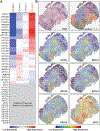Spatial transcriptomics of a giant pilomatricoma
- PMID: 37649312
- PMCID: PMC10591970
- DOI: 10.1111/cup.14524
Spatial transcriptomics of a giant pilomatricoma
Abstract
Pilomatricomas (PMs) are common benign adnexal tumors that show a predilection for the head and neck region and are characterized at the molecular level by activating mutations in the beta-catenin (CTNNB1) gene. Giant PMs are a rare histopathological variant, according to the World Health Organization, which are defined by a size greater than 4 cm and are reported to show upregulation of yes-associated protein compared to PMs of typical 1-3 cm size. We describe the case of a 67-year-old man with an 8 cm giant PM involving his temporal scalp, whose PM we characterized by 10X spatial gene expression analysis. This revealed five total transcriptomic clusters, including four distinct clusters within the giant PM, each with a unique transcriptional pattern of hair follicle-related factors, keratin gene expression, and beta-catenin pathway activity.
Keywords: adnexal and skin; beta-catenin; gene expression profiling; neoplasms; pilomatricoma; spatial transcriptomics.
© 2023 The Authors. Journal of Cutaneous Pathology published by John Wiley & Sons Ltd.
Conflict of interest statement
Figures





References
Publication types
MeSH terms
Substances
Grants and funding
LinkOut - more resources
Full Text Sources
Medical
Miscellaneous

